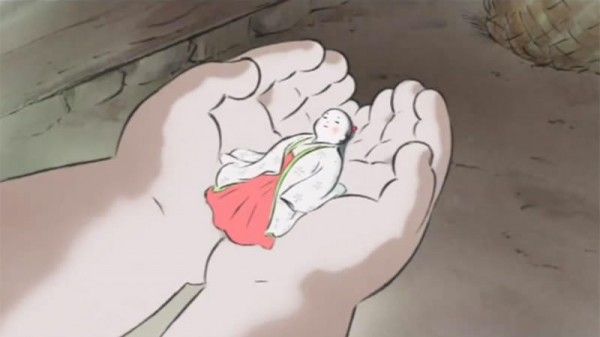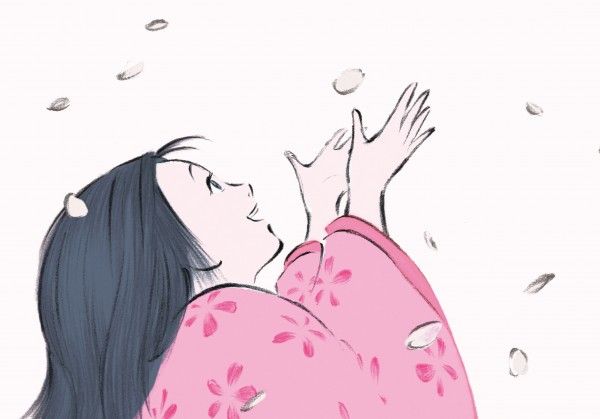[This is a re-post of my The Tale of Princess Kaguya review from the 2014 Toronto International Film Festival. The film opens today in limited release. Please note that this review is for the original Japanese-language version, so there is no critique of the English-language dubbing or the voice acting.]
Studio Ghibli’s films have always embraced the connection between nature and magic, and The Tale of Princess Kaguya continues this tradition in fine form. Writer-director Isao Takahata, who also co-founded Studio Ghibli, breaks from the company’s familiar animation style to venture into a sumi-e look that perfectly suits the story’s celebration of nature’s simplicity and magnificence. Although Kaguya does become slightly redundant in highlighting its heroine’s values before the film indulges in an abrupt revelation, Takahata and Ghibli have still found fresh life in their classic themes.
A bamboo cutter is working in the forest one day when a tree begins to glow. As he approaches it, a plant blooms to reveal a tiny girl dressed in fine robes. He picks her up in the palm of his hand and takes her home to his wife whereupon the girl transforms into a normal, healthy, crying baby. The bamboo cutter takes this to be a sign that her original form indicated the girl’s destiny is to be a princess. The girl, Kaguya, physically ages through childhood and adolescence quickly (“like a bamboo shoot!” a playmate observes), but she’s overjoyed to be enjoying the wilderness around her. However, when another bamboo tree provides the cutter with gold, he uses their new wealth to move his family to the Capital and transform the girl into the princess he believes she was meant to be even though she’d rather be among nature and away from callow suitors.
The movie is based on a 10th century Japanese folktale, and Takahata beautifully animates his picture to the art style of the time period rather than create a straight adaptation. The story has a deep emphasis on appreciating the simple beauty of nature. Kaguya and her rural friends happily sing a song celebrating birds, beasts, grass, flowers, and so on. The more organic art techniques like watercolors, pens, and pencils are in tune with the simple life Kaguya wants to lead.
There’s a cuteness and vivacity to Princess Kaguya that’s immediately endearing, which is surprising since we’ve seen other Ghibli movies, e.g. My Neighbor Totoro, Spirited Away, and Arrietty to name a few, revel in the enchantment of nature. Kaguya stands apart thanks to its art style and that Takahata decides to embrace the story’s folk roots. The movie feels like a long-form folktale with the director having the freedom to provide more detail to the characters’ personalities while allowing familiar folklore tropes like poor origins and wealthy suitors to provide the story beats. For example, the movie paints Kaguya’s father as somewhere between a doting parent and a pageant mom—he truly believes what he’s doing is best for his daughter, but he’s also relishing the respect and attention he receives because noblemen want to marry her.
But folktales are foremost about structure—we know Jack climbs the beanstalk, but the tales vary with regards to Jack’s emotional state—and Kaguya misses a major setup that results in a reveal coming off as comical in its randomness. Had Takahata even alluded to this reveal, it would have played wonderfully because the symbolism makes total sense. But without a set up, a movie that was already running long (there comes a point where Kaguya is dancing among cherry blossoms, and all we can say is, “Yep, nature sure is great.”) now feels like it’s trying to find an ending and came upon one that’s almost completely arbitrary. Takahata’s confident direction and the charming tale are enough to have the movie recover, but it’s still jarring when any storyteller has to go, “Wait. I mentioned this earlier, right? No? Well, okay, I’m telling you now.”
Thankfully, it’s still an enchanting movie and one that dances between joyous and bittersweet. It’s a lament for lost seasons, lost wilderness, and lost childhood. Like any well-told folktale, The Tale of Princess Kaguya eloquently weaves a captivating narrative that paints in broad strokes but is still detailed enough to land an emotional impact. And even when the movie it stumbles, it has the strength to gracefully stand up, smile, and keep playing in the wonders of nature.
Rating: B



